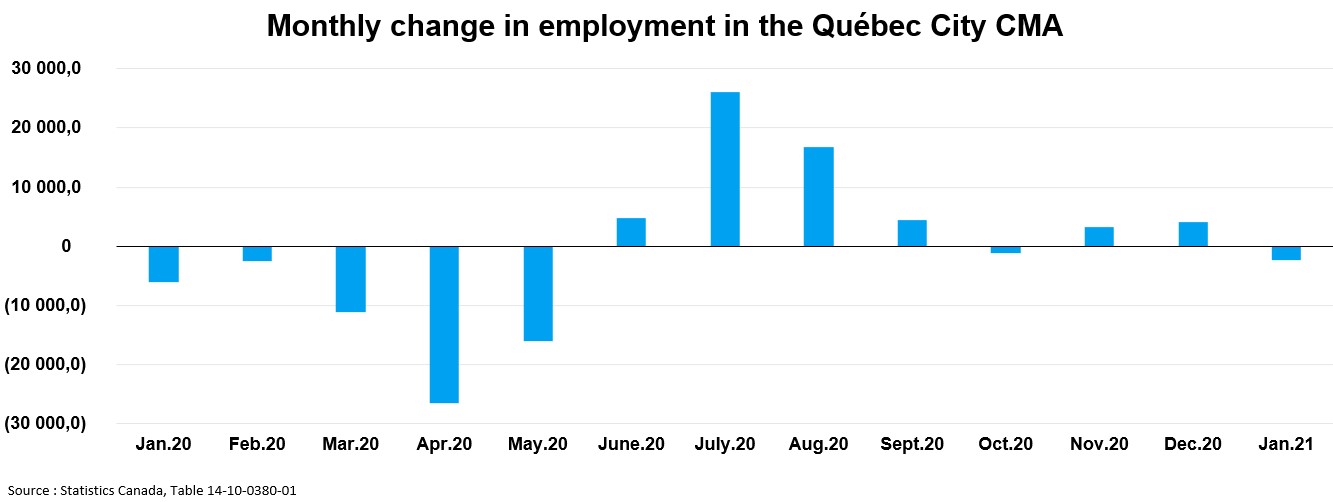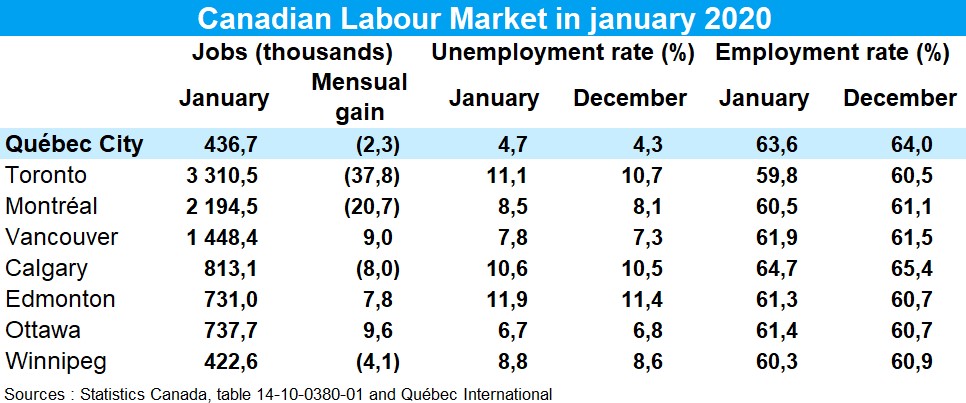Highlights
- The Québec City census metropolitan area’s (CMA) labour market lost 2,300 jobs (-0.5%) from December 2020 to January 2021. Nevertheless, the total number of jobs was higher than at the same time last year (January 2020).
- The unemployment rate reached 4.7% in January, a slight increase compared to December (4.3%). Québec City remains the region with the lowest rate among major Canadian CMAs.
- Both the labour force participation and employment rates dropped slightly from December 2020 to 66.7% and 63.6%, respectively, in January. Despite this decrease, both the labour force participation and employment rates were similar to those observed at the same time last year (January 2020).
- Despite positive results in the labour market in recent months, some sectors still suffer greatly from the current context, chiefly the accommodation and food services industries.
- In the province of Quebec, comparable data shows a decline in employment of 36,200 jobs (-0.9%) in January, while the unemployment rate increased from 7.2% in December to 7.6% in January.
Charts


Commentary
Statistics Canada’s Labour Force Survey (LFS) data for January shows the labour market conditions during the week of January 10 to 16. These are the first figures published since the Quebec government’s new measures were implemented at the end of 2020, namely the curfew and the restrictions for non-essential shops and services.
Note that data for December 2019 in that document differs from the data published in the January 8 edition of our economic news. This is due to the recent revision of historical data by Statistics Canada. See the footnote below for more information.
The labour market slowed down in January
In January, Statistics Canada estimated that there were 436,700 jobs in the Québec City census metropolitan area (CMA), a decline of 2,300 jobs (-0.5%) from December. This result is better than in the province of Quebec (-0.9%) and close to the Canadian result (-0.4%). Nevertheless, the total number of jobs in the Québec City region is higher than at the same time last year (January 2020).
The unemployment rate reached 4.7% in January, a slight increase compared to December (4.3%). Québec City remains the region with the lowest rate among major Canadian CMAs. Note that Québec City’s unemployment rate is still low from a historical standpoint. In January, there were an estimated 21,400 unemployed people, more than the 19,300 registered the previous year (January 2020).
Both the labour force participation and employment rates dropped moderately from December 2020 to 66.7% and 63.6%, respectively, in January. Despite this decrease, both the labour force participation and employment rates were similar to those observed at the same time last year. There were 458,100 people in the labour force in January 2021, 1,600 more than at the same time in 2020.
Unequal effects
Despite the positive results in the labour market in recent months, some sectors and categories of workers are especially affected by the current context. Non-deseasonalized data reminds us that the accommodation and food services industries, as well as younger workers (aged 15 to 24), are among the most affected by the crisis.
Note to readers
The labour force estimations and geographic limits of each territory are revised after each census. This standard procedure took place in January 2021 and had little impact on labour market trends. The estimations are now adjusted based on the demographic information from the 2016 census, and geographic limits now align with the census divisions. The Québec City CMA now includes the municipality of Saint-Antoine-de-Tilly. To learn more, check out The 2021 Revisions of the Labour Force Survey.
The available data for the Québec City census metropolitan area (CMA) was given special statistical treatment (three-month moving average) due to the small sample size, which has the effect of mitigating the large fluctuations in the data. Thus, the data collected in November and December influenced the estimations published for January. Please also note that we use comparable data for the province of Quebec and other CMAs in this document. To learn more, please check out these reminders about moving averages (ISQ, in French only).
The Labour Force Survey’s (LFS) data for January was collected from respondents during the reference week of January 10 to 16. Therefore, the “red zone” status and the new measures like the curfew are reflected in the data presented. For more details, please see the Government of Quebec’s map of COVID-19 alert levels by region.
Émile Émond
Economist
Québec International




